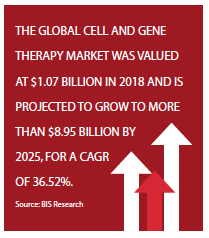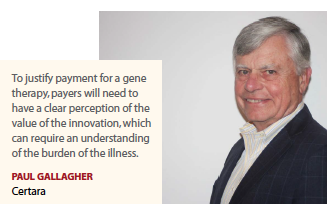Having a well-designed plan that addresses the needs of all stakeholders — patients and their families, medical institutions, payers and manufacturers — will help drive successful outcomes.
The advent of gene therapy — personalized medicine reflecting the potential to minimize or cure disease — is an extremely exciting field in disease management. This new frontier has vast opportunities, but also potential challenges.
A handful of gene therapies are FDA-approved with dozens more in the pipelines of biotech and pharma manufacturers, big and small. Rare diseases are poised to reap some of the greatest benefits given that an estimated 80% of rare diseases are attributable to an underlying genetic culprit.
 Gene therapy development is expected to pick up pace, according to analysts at GlobalData. But there are also challenges associated with the development of gene therapies, most prominently being their high price points. Key opinion leaders interviewed by GlobalData highlighted the need to create sustainable funding solutions so that such therapies become accessible to patients everywhere irrespective of where patients are located.
Gene therapy development is expected to pick up pace, according to analysts at GlobalData. But there are also challenges associated with the development of gene therapies, most prominently being their high price points. Key opinion leaders interviewed by GlobalData highlighted the need to create sustainable funding solutions so that such therapies become accessible to patients everywhere irrespective of where patients are located.
The gene therapy community is at a pivotal point, with several approved gene therapies on the market — Kymriah, Yescarta, and Luxturna; Zolgensma has been approved but has not launched. The Alliance of Regenerative Medicine (ARM) reports that more than 700 cell and gene therapies are currently being developed, including nearly 50 therapies in Phase III trials.
Gene therapies are transformative and innovative in their molecular mechanisms of action and their one-and-done administration, potentially providing cures for very serious, progressively life-threatening diseases, many of which have no good alternatives. They offer great benefits, but also great challenges to health systems.
“The gene therapy field has overcome many obstacles to reach its current state where the FDA has begun issuing approvals," says Daniel Eisenman, Ph.D., director, biosafety services, Advarra. “For the field to succeed, some remaining obstacles must be overcome, such as pricing and payment method. Governments and insurance companies are still debating how to pay for gene therapies, which may range from hundreds of thousands of dollars to a few million dollars to treat a single patient. Pharmaceutical companies must have a means of recouping  costs and show profits to reward their risks and innovations and encourage the field to grow. Creative approaches to this dilemma include performance-based payments where the price is spread out over several years as long as a gene therapy continues to deliver its anticipated results."
costs and show profits to reward their risks and innovations and encourage the field to grow. Creative approaches to this dilemma include performance-based payments where the price is spread out over several years as long as a gene therapy continues to deliver its anticipated results."
“We have seen that both payers and the companies bringing these therapies to market are struggling with the changing reimbursement paradigms needed for these therapies," says David Fischer, Ph.D., executive director discovery sciences, scientific advisory services, Charles River. “They are very expensive to develop and are typically only intended to treat a small patient population. Long-term efficacy studies, both clinical and preclinical, would potentially help in building the case for a potential cure as the outcome of a single administration."
Some of the most important considerations for a gene therapy’s success postapproval will be the access and reimbursement policies, says Cynthia Verst, Pharm.D., president, R&D Solutions, IQVIA. “Typically, marketed products in this space command price tags well more than $1 million per patient so, for governmental agencies as well as private payers, true availability of these medicines will remain the primary challenge for the foreseeable future," she says. “A successfully marketed gene therapy will need a well-vetted plan with clear labeling for the intended sub-patient populations, as well as the entire episode of patient care."
Ms. Verst says success in the market will largely be defined by the therapy’s durability of response, which is often considered the most important indicator of value. “Some gene therapies may be able to yield long-term and/or curative benefits, but many may not provide more than periodic relief and, given their pricing, this could substantially affect how the success of a marketed gene therapy is both defined and evaluated,"she says.
She says this “outcome-based performance reimbursement" will require a scientifically robust and cost-sensitive method of collecting long-term outcome evidence. “The ability to design innovative postmarketing programs and to link longitudinal real-world evidence with primary datasets for individual patients to demonstrate long-term effectiveness and safety will be key for gene therapies to succeed after FDA approval," Ms. Verst adds.
Payers are Key to Success
Payers are expected to hold the key for successes, and the cost and coverage of gene therapies will be hot topics for years to come. Current therapies require a  close partnership among all stakeholders, with the manufacturer often providing a single point of contact to navigate insurance coverage and connect patients with resources as needed.
close partnership among all stakeholders, with the manufacturer often providing a single point of contact to navigate insurance coverage and connect patients with resources as needed.
McKinsey says the pharma industry must recalibrate its development and reimbursement model for therapies that go beyond the traditional approach to disease treatment.
Our industry experts say for gene therapies to be adopted successfully, the biopharma company must understand and address the needs of four key stakeholders: patients; providers — both care deliverers and institutions; payers; and policymakers. The industry is already seeing novel reimbursement models, such as pay-over-time options and outcomes-based models, start to emerge. These are good options, but experts say additional, more creative solutions that can get these therapies in the hands of patients who desperately need them as efficiently as possible are required.
Gene therapies strain the traditional reimbursement model where therapies are administered in small doses over a long period of time, says Daryl Spinner, Ph.D., managing director, real-world value and strategy, Evidera.
“Therapies are typically reimbursed as they are provided, and since gene therapies tend to be administered only once and offer extraordinary value, payment commensurate with their value is expected upfront," he says. “This results in a single relatively high payment, sometimes $1 million or more, where payers are required to compensate the full value of gene therapy upfront and by extension believe that the value promised will be sustained and fully realized over the long term."
The wholesale acquisition cost (WAC) of each of the three CGTs launched to date has remained less than $1 million, but Novartis announced its recently approved gene therapy for the treatment of spinal muscular atrophy (SMA) will have a $2.125 million WAC. It is expected that Zynteglo from bluebird bio, approved by the EMA and seeking FDA approval for the treatment of transfusion dependent beta thalassemia in late 2019, will likely be priced above $1 million as well.
Greg Skalicky, chief revenue officer, Eversana, says manufacturers will need to have commercial strategies ready for these emerging therapies well in advance of product launch.
“To truly drive the commercialization of gene therapies we must build an ecosystem of solutions that ultimately delivers more value to patients, faster," he says. “What does this look like? The patient is at the center of this revolution. Service silos are gone. Solutions are seamlessly integrated, building upon each  other as development moves through the product lifecycle. Patients are recruited into clinical trials earlier. Manufacturers have deeper insight into the patient experience. HEOR breaks down and helps to inform complex market access strategies and patient services. Field force solutions provide the strategies and tools needed to mitigate risk, achieve adherence and compliance, and the ability to measure economic value."
other as development moves through the product lifecycle. Patients are recruited into clinical trials earlier. Manufacturers have deeper insight into the patient experience. HEOR breaks down and helps to inform complex market access strategies and patient services. Field force solutions provide the strategies and tools needed to mitigate risk, achieve adherence and compliance, and the ability to measure economic value."
Analysis by Trinity has found the current reimbursement model is rapidly becoming unsustainable. Gene therapies’ unique value profile does not fit into the current U.S. insurance model, as payers remain unequipped to pay for these therapies. Payers interviewed by Trinity expressed uncertainty about how these therapies will be funded in the future. With about 20% annual turnover of commercially insured patients, there is a high risk that after a payer authorizes access to a gene therapy, the patient may move to another plan before the plan is able to realize any cost savings.
Are Creative Payment Solutions the Answer?
A range of industry stakeholders, including manufacturers, patient-advocacy groups, and payers have recognized the need to adapt or replace the standard payment system if gene therapy is to become widely available. Several alternative payment mechanisms have been proposed, including annuity-based payments, outcomes-based payments, outcomes-based rebates, and outcomes-based annuities (see sidebar).
McKinsey researchers say current price-reporting requirements in the United States limit the ability of manufacturers to offer outcomes-based payments and payments over time. Under best-price regulations, they must report all prices paid for therapy, with the lowest price — or the average price minus a specified percentage, likely to be 23% for gene therapy — becoming the benchmark paid within U.S. Medicaid programs and the government’s 340B drug-discount program.
Trinity’s interviews with payers have found that novel contracting agreements may not be enough to address the high costs of cell and gene therapies. The American health insurance industry is not prepared to finance such high-cost therapies. Today, in addition to increases in insurance premiums, in order to afford these therapies, plans frequently rely on stop-loss insurance, additional insurance purchased to protect against catastrophic or unpredictable losses. But reinsurance rates increase with utilization, and reinsurance plans will be unable to maintain profits and remain viable.
Trinity has found interest in such innovative arrangements does not exist beyond national payers, such as United, Anthem, Aetna, Cigna, Humana, and even among these payers interest is limited for cell and gene therapies. In fact, no  payers within Trinity’s sample had, or were building, functional capabilities to enact such contracting agreements with manufacturers. Annuity- and outcomes-based payment models have generated much attention, yet the majority of payers preferred to pay a single lump sum due to the small treated patient populations and low resulting impact to a plan’s budget that would not reduce medical spend nor justify the development of a complex alternative payment model.
payers within Trinity’s sample had, or were building, functional capabilities to enact such contracting agreements with manufacturers. Annuity- and outcomes-based payment models have generated much attention, yet the majority of payers preferred to pay a single lump sum due to the small treated patient populations and low resulting impact to a plan’s budget that would not reduce medical spend nor justify the development of a complex alternative payment model.
Trinity’s interviews found annualized payment models garnered little enthusiasm among payers; nine of 10 interviewed medical directors flatly rejected this option. Payers realize that annualized models will not discount cell and gene therapies’ costs and thus won’t impact their bottom line.
Additionally, medical directors are not interested in paying for a patient’s therapy after the person has died or otherwise left the plan. This contracting would require universal coverage decisions and unrealistic coordination between plans that would include the sharing of sensitive information with direct competitors.
Our experts say demonstrating value of gene therapies will be critical.
The most effective way to prepare for post-approval success is to generate strong evidence of sustained value in the target patient population, Dr. Spinner says.
“This requires planning early in clinical development for evidence needed to support acceptance by all key stakeholders," he says. “Persuading payers to reimburse for high value medicines upfront requires demonstrating sustained, disease-relevant, patient-centric outcomes such as impact on survival and disease progression, improved functioning, and reduction or elimination of other disease-associated medication and health resource utilization.
Dr. Spinner says even with such evidence, payers are straining to pay for the full value upfront and are more open to pricing models that allow for payment in installments based on confirmation of sustained, predefined patient outcomes at specified intervals, for example, a smaller payment upfront with yearly payments until the total therapy price is paid.
To justify payment for the therapy, payers will need to have a clear perception of the value of the innovation, which can require an understanding of the burden of illness, particularly if it is an orphan disease, so they can evaluate the eligible patient population, says Paul Gallagher, VP, U.S. access strategy, Certara. “Payers will also require substantial evidence of the product’s efficacy, particularly of durability so that they can assess the risk of large up front financial commitments for a one-time treatment versus competitive chronic therapies if any."(PV)
~~~~~~~~~~~~~~~~~~~~~~~~~
Alternative Payment Mechanisms
A range of industry stakeholders, including manufacturers, patient-advocacy groups, and payers have recognized the need to adapt or replace the standard payment system if gene therapies are to become widely available. Several alternative payment mechanisms, including the following, have been proposed:
Annuity-based payment. The payer agrees to pay a fixed price for the therapy and pays in regular installments, like with an annuity, spreading the cost over time.
Outcomes-based payment. The payer pays only a portion of the full price up front. If the therapy achieves prespecified outcomes, the payer pays the remainder in full. This model spreads the risk, therefore, between the payer and manufacturer.
Outcomes-based rebate. The payer pays the full price of the drug up front but receives a rebate if the drug does not achieve prespecified outcomes. This model, again, spreads the risk between the payer and manufacturer.
Outcomes-based annuity. The payer pays a fixed price, with payments spread over many installments, but only if the drug continues to meet certain prespecified outcomes. This model, too, spreads the risk between the payer and manufacturer.
Source: McKinsey
~~~~~~~~~~~~~~~~~~~~~~~~~
The Need for Education
 Laurie Bartolomeo
Laurie Bartolomeo
Executive VP, Creative Director, Dudnyk
First and foremost, there have to be patient populations that receive a diagnosis and are ready and willing to participate in a trial. One way to find these patients is to drastically improve access to more broad-based genetic testing such as partial and whole genome sequencing. Currently, there are many barriers blocking this access — not just from a lack of awareness and education, but also from financial, geographic, and sometimes even philosophical/religious standpoints. As industry leaders, we should be breaking down these barriers and driving patients to the answers they need and, ultimately, to these life-changing treatments. Secondly, as gene therapy approvals increase, there will be a need for a significant shift in the mindset of clinicians as they evaluate the value of these therapies and how they communicate that value to patients. Gene therapy trials, by necessity, are often conducted in small patient populations using nontraditional efficacy measures. There is often no randomization, few or non-existent p values, and all too often the improvements patients experience cannot be measured by any existing clinical scale. In some cases, such as that of the first gene therapy for inherited retinal diseases, investigators had to create their own measurement tool to evaluate the ability of a therapy to improve functional vision, a concept previously unknown to clinicians. Another example would be the challenges facing gene therapies in development for neurological disorders in children. The developmental improvements these therapies can offer may not be able to be measured with traditional tests. What may seem small and incremental to clinicians might be considered absolutely life-changing for the child and the family. Tough conversations will have to happen to determine when and if such a gene therapy is “worth it" for a family, and how that worth is determined will hinge largely on empathy and understanding of what is meaningful to patients.
Julianne Dunphy, Ph.D.
Director of Medical Strategy and Solutions, Cambridge BioMarketing
What was once the stuff of science fiction is now potentially life-saving reality. As new technologies continue to emerge, it’s abundantly apparent that ‘gene therapy’ is not, and will never be, one thing. Along with potential for immense benefit, there’s also room for confusion, misinformation, and misperceptions about these novel technologies, which manufacturers will need to proactively address through well-crafted, simple, and clear communications. Seamless manufacturing and distribution, commercialization strategies, and flawless patient support services are obvious practical success factors. Novel pricing models have already been developed, and more are in the works. But importantly, to succeed in the long term, manufacturers must establish “product-plus" value while simultaneously setting clear treatment expectations among HCPs, patients, families, and the public alike. For many, the dream of gene therapy has historically occupied the same mind space as “cure"— it’s the ultimate goal, but it’s also a tall order. Not all gene therapies hold curative promise and those that do must stay vigilant about unforeseen, future concerns about safety and yes, even the potential for waning efficacy. Long-term data, real-world evidence collection, and patient input are critical to solidify and bolster the incredible promise gene therapies offer us. The future is waiting.
 Don Gabriel, M.D., Ph.D.
Don Gabriel, M.D., Ph.D.
Senior Director, Medical Oncology and Scientific Strategy, UBC
Education of the physician and staff will be required to assure the proper handling and administration of the therapy. Unique adverse events will need to be recognized and appropriately managed, making pharmacovigilance even more important. In the case of genetically engineered stem cells, an approved stem cell laboratory and staff will be required to ensure proper management of the engineered stem cells. The cost of production and the time from diagnosis to availability of the product will be important in some situations.
Finally, the patients will require entry into a registry for long-term follow-up to identify any potential late adverse events. Providers require clinical evidence to support their initial benefit-to-risk assessment. Once they are convinced of its value, payment for the product and its administration must be assured. They will likely require support from the gene therapy developer in managing insurance hurdles.
 Amy Graham
Amy Graham
Client Engagement Officer, Ogilvy Health
The success of gene therapy requires careful planning and alignment from all stakeholders to ensure the best delivery and outcomes for patients. The personalized nature of gene therapies, along with limited shelf life and stability, mean that products cannot necessarily be manufactured in bulk. So, even when the manufacturer secures approval, there may still be delivery challenges to address.
~~~~~~~~~~~~~~~~~~~~~~~~~
The Challenge of Manufacturing of Gene Therapies
 Dr. Andre Choulika
Dr. Andre Choulika
CEO, Cellectis
For gene therapies to succeed following approval, we need to make them affordable and readily available for patients. One way to do this would be to develop off-the-shelf gene therapies that are universally available to all patients instead of autologous therapies that are individualized to each patient. Imagine a doctor being able to diagnose a patient and having the opportunity to immediately grab a treatment from the freezer to give to someone without other options? The second way would be to put more resources toward expanding and scaling up of manufacturing capabilities so that companies would have enough product to meet the demand for those who are in need of treatment in real time.
 Joe DePinto
Joe DePinto
President, Specialty Solutions,
Cardinal Health
While the potential impact on patient outcomes is exciting, the innovative science behind cell and gene therapy poses challenges not only in clinical research, but also in transitioning from clinical trials to full-scale commercial availability. The market and channel access approaches used for other pharmaceutical products may not be optimal for the launch of highly targeted therapies due to their specialized administration and logistics requirements, as well as their cost. Because the manufacturing of cell and gene therapies may involve the manipulation of patients’ cells, the potential for variability is significant and can add risk not only for manufacturers, but also for patients and providers. This risk must be mitigated by selecting partners along the value chain that understand the systematic process and are committed to process engineering, excellence in complex operations, and careful and timely delivery.
 Daniel Eisenman, Ph.D.
Daniel Eisenman, Ph.D.
Director, Biosafety
Services, Advarra
As the field and demand for gene therapies expand, technology must also be developed to increase manufacturing efficiency. Several manufacturers are currently developing benchtop manufacturing equipment to replace the need for expensive and highly specialized manufacturing facilities and to address the need for therapies that are more personalized.
Greater manufacturing capabilities will help speed up production and decrease cost; a shortage of facilities for manufacturing gene therapy products is currently hampering growth. And as more investigational therapies win approval and become common clinical treatments, public acceptance and willingness to participate in more clinical trials will likely increase: success begets success.
 Gaurav Shah
Gaurav Shah
CEO, Rocket Pharmaceuticals
An important consideration in gene therapy is manufacturing. Once a therapy has been approved, companies will need to be prepared to scale up manufacturing capabilities to meet market demand and get therapies to patients quickly. Because the indications being pursued are rare, there will be a need to balance this scaled-up manufacturing capability with demand.
Greg Skalicky
Chief Revenue Officer, Eversana
Cell and gene therapy may be headline news for good reason, but there are millions of individuals who need and will continue to need access to medicines. Pharmaceutical manufacturers will continue moving forward with the important and necessary research for and development of therapies that save lives. How they do it may be changing, though.
Growing competition, innovative technologies such as AI and predictive analytics, and an industrywide decrease in product pipelines and blockbuster drugs, have put a new focus on biotech companies as catalysts of innovation. Just think of their impact on personalized medicine and the explosive growth of gene therapies. I believe a result will be an increase in large pharma companies partnering with, merging, or acquiring biopharma companies for future growth potential in innovative new therapies focused on precision and preventative medicine.
 Karen Young
Karen Young
U.S. Pharmaceutical and Life Sciences Leader, PwC
The biggest challenges are developing the right manufacturing capacities and finding the right talent to staff your organization. There’s a lack of both talent and manufacturing capacity in the industry right now, and it has the potential to slow down companies that want to scale quickly after approval.
After companies figure that out, they need to figure out how to get their products to patients. Here, an advanced cold-chain is going to be essential, and companies should think about how to keep patients and providers informed throughout the process to ease patient anxiety and allow for close coordination around treatment.
















